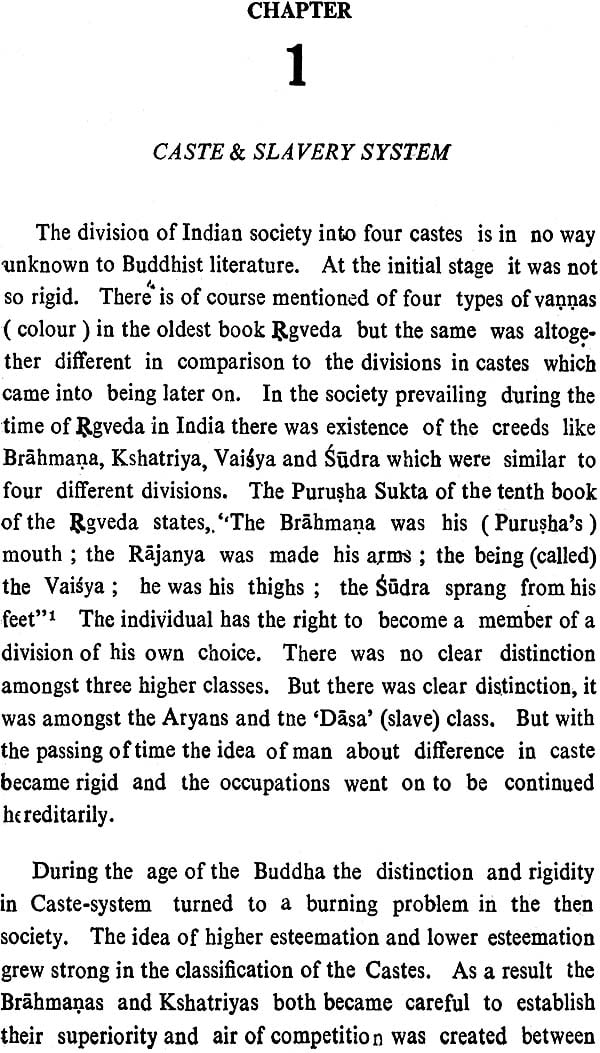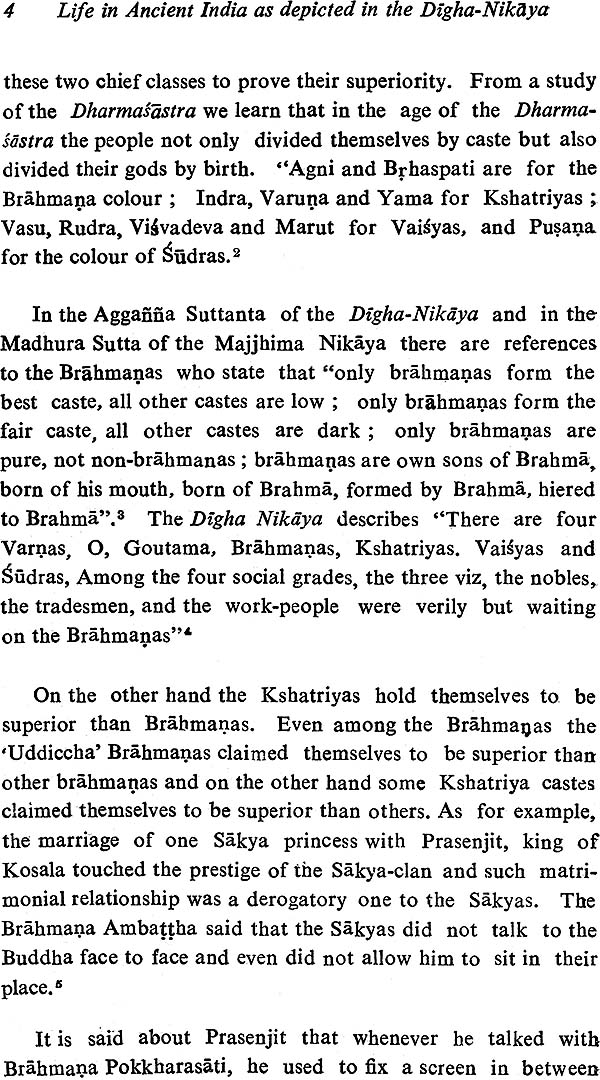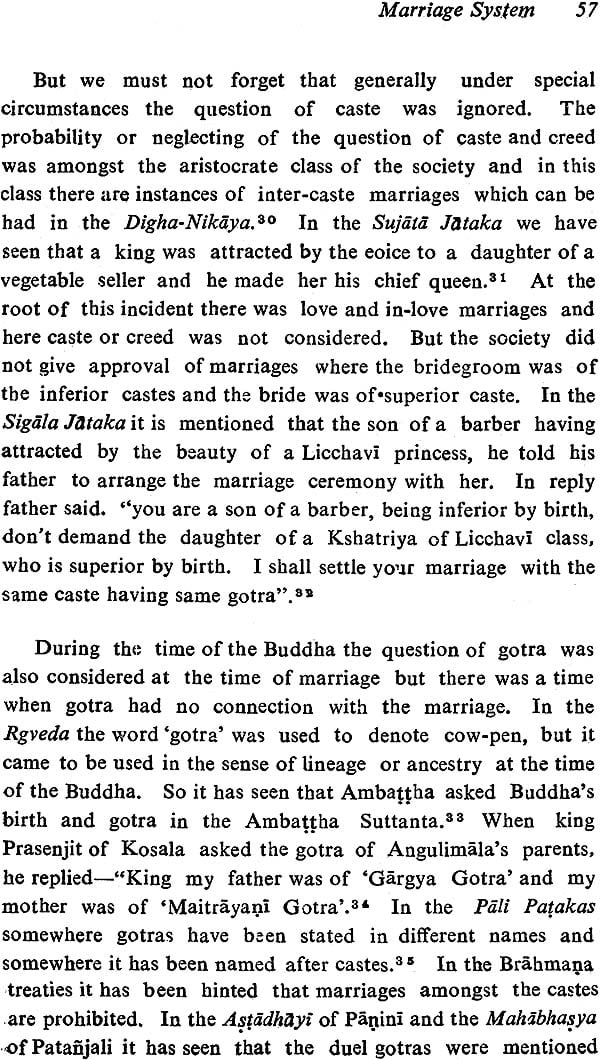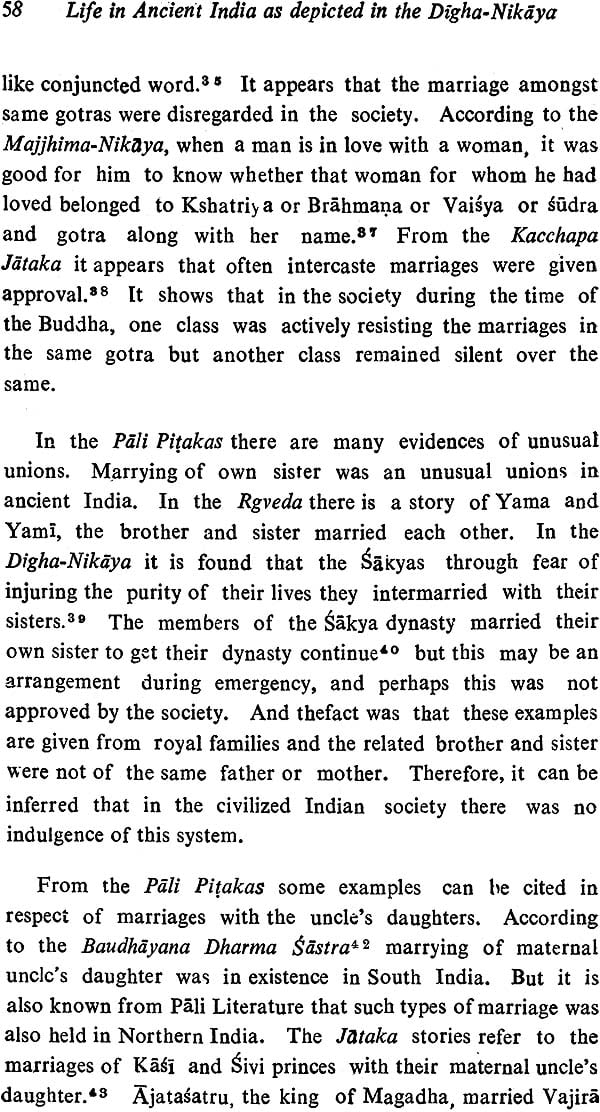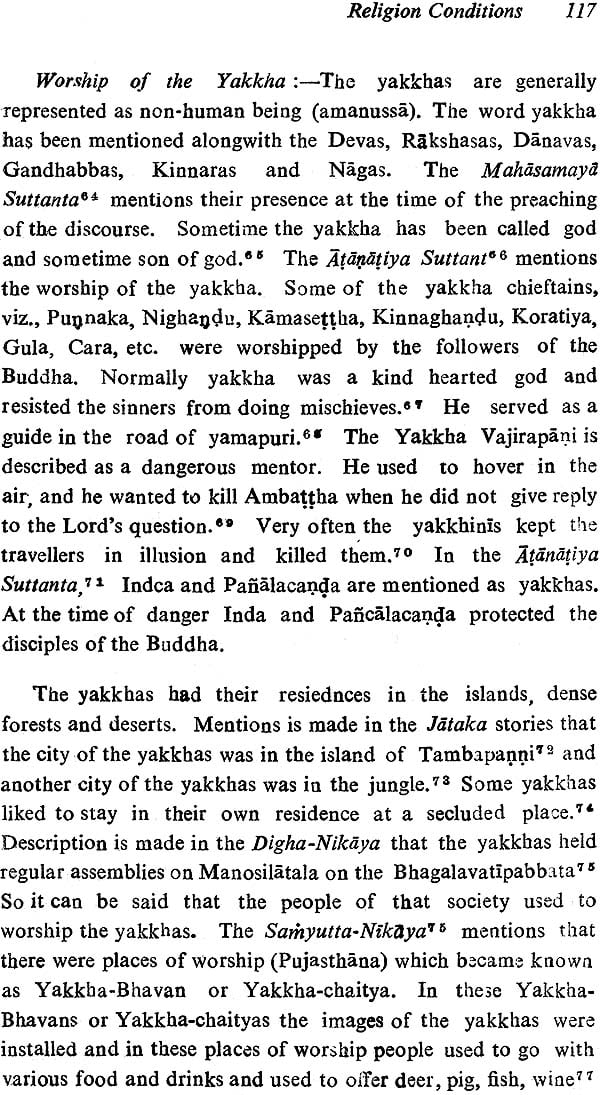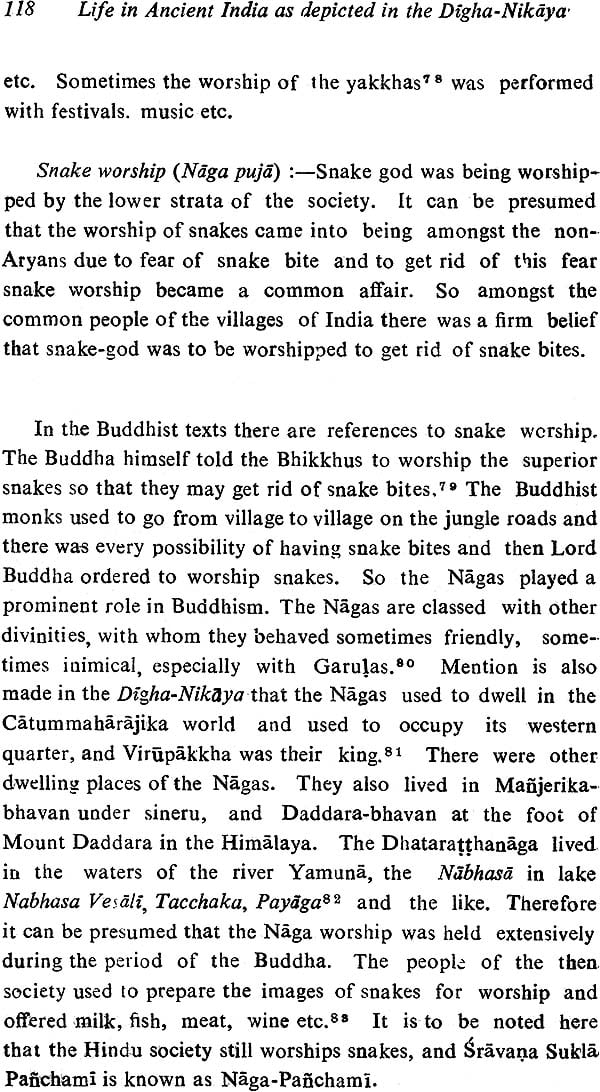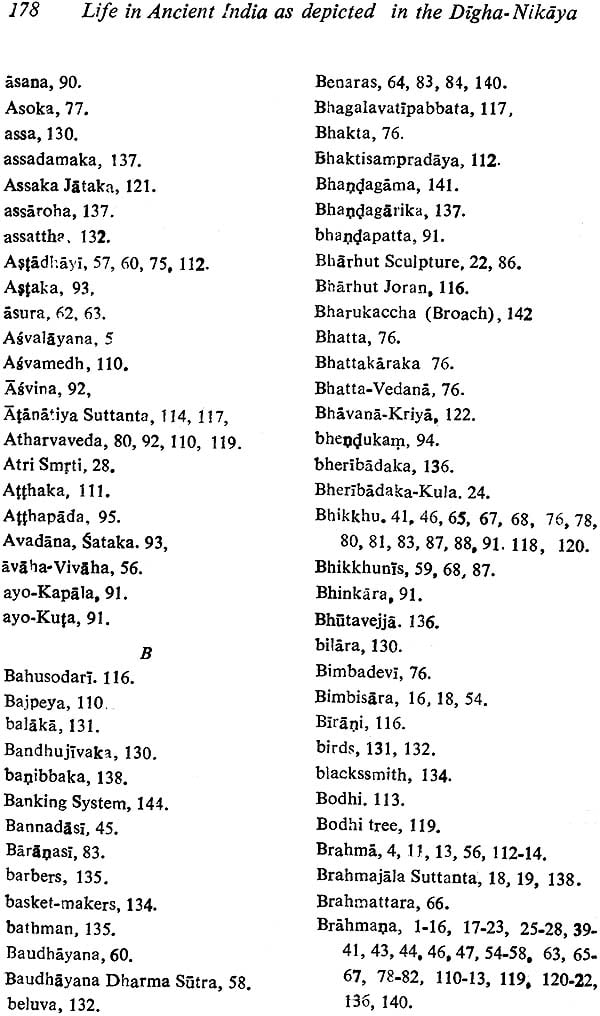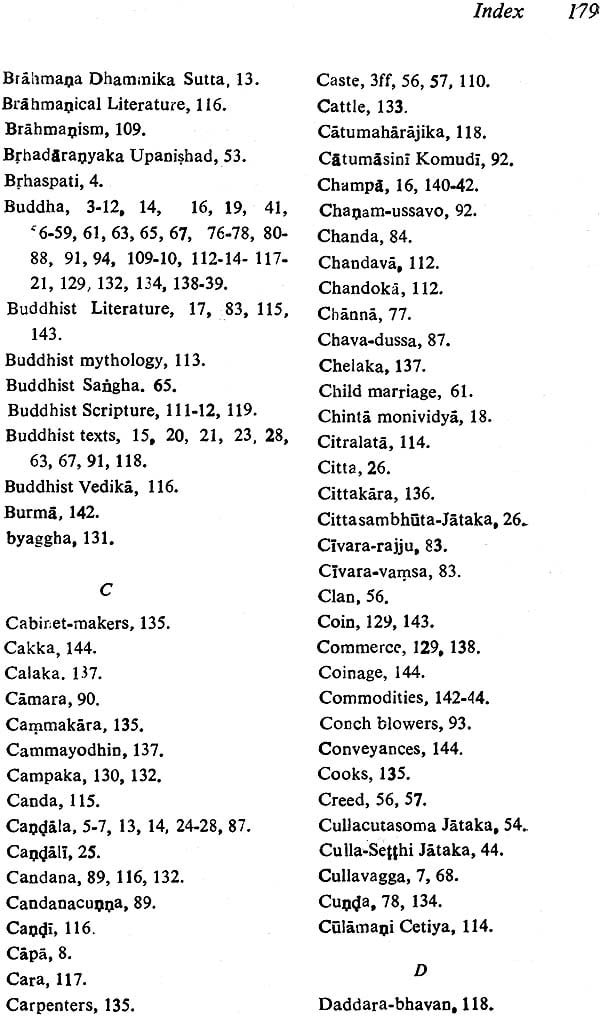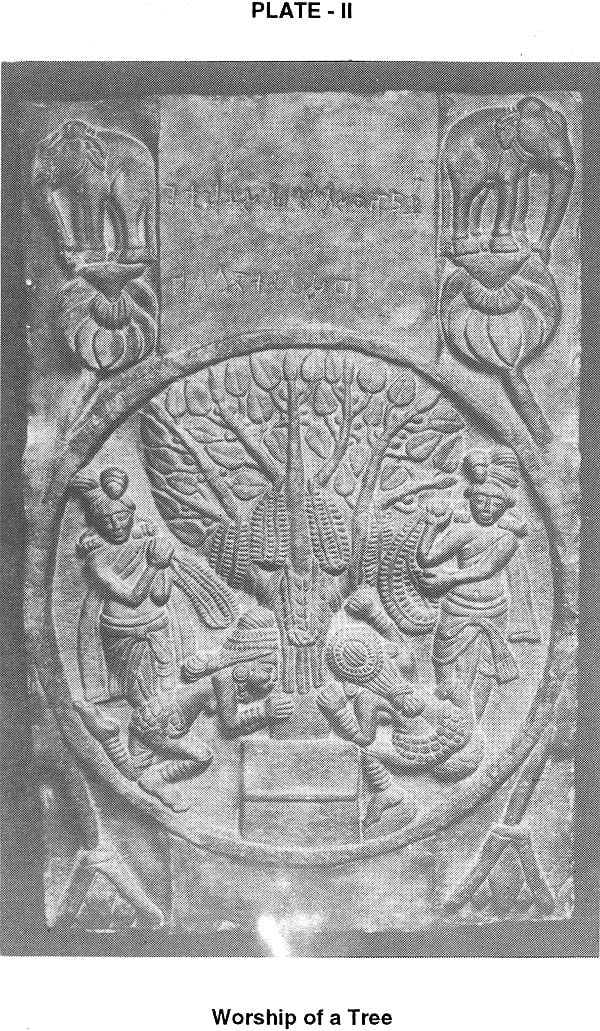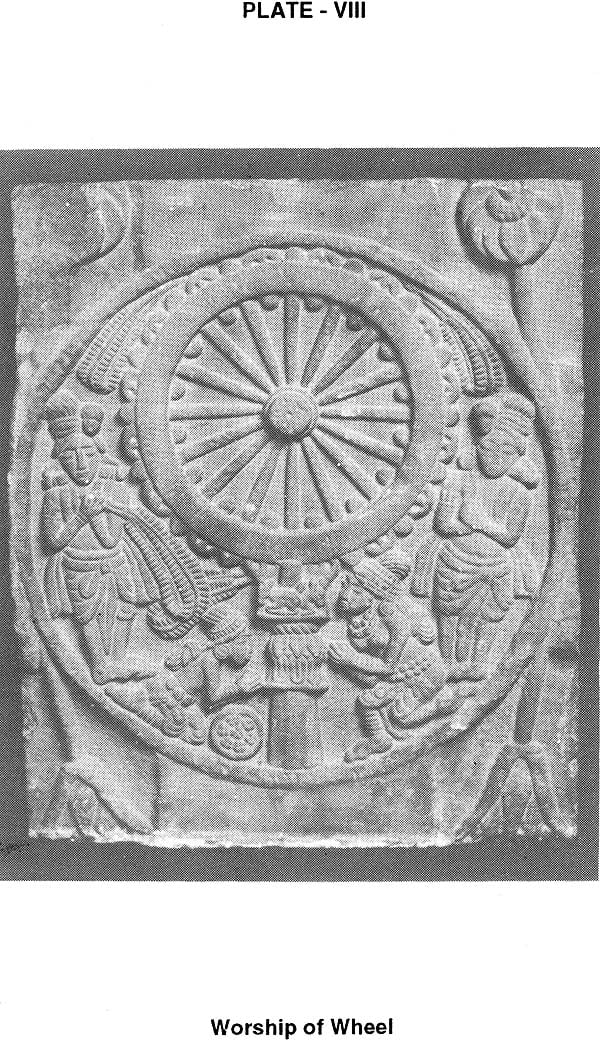
Life in Ancient India (As Depicted in The Digha-Nikaya): An Old Book
Book Specification
| Item Code: | NAJ357 |
| Author: | Dr. Chittaranjan Patra |
| Publisher: | PUNTHI PUSTAK |
| Language: | English |
| Edition: | 1996 |
| ISBN: | 8185094934 |
| Pages: | 237 (10 B/W Plates) |
| Cover: | Hardcover |
| Other Details | 8.5 inch X 5.5 inch |
| Weight | 330 gm |
Book Description
About the Book
The Digha - Nikaya provides us with a pan-picture of the socio-economic as well as religious condition prevalent in ancient India at the time of its compilation. Though the aims and objects of the Suttantas of the Digha - Nikaya are not avowedly secular, the Suttantas depict society from an independent point of view, and give details, specially, of the darker phases of social life with the fullness and vairety that we generally miss in the sacred texts: Here in this book an attempt has been made to draw a picture of the caste and slavery system, marriage system, food and drinks, furniture and ulensils and amusements, games and sports, religious and economic condition of the people.
About the Author
Dr. Chittaranjan Patra was born in 1960 and did his MA (Gold Medalliest), PhD., B.Lib. Sc. from Calcutta University. At present he is working as a lecturer at the Indira Gandhi National Open University and also working as a Cataloguer at the Indian Museum, Calcutta. He has in his credit a book on “Present Buddhist Tribals and Viqharas in West Bengal” published in 1991 and a number of articles on various aspects of Buddhism published in different journals and he attended and read paper in the seminar held in different parts in India. He is now engaged in writing a book on the Chinese Buddhists in Calcutta.
Preface
The Digha-Nikaya offers us a clear idea in the presentation of the picture of social life in ancient India at the time of its compilation. Though the aims and objects of the Suttantas of the Digha-Nikaya are not avowedly secular, they depict society from an independent point of view, and give details, specially -of the darker phases of social life, with the fullness and variety that we naturally miss in the ‘Sacred texts’. We can see in them marchants and artisans, workers and peasants, women, old people and ascetics, Brahmins and princes-all engrossed in their daily lives. We see that the Digha Nikaya’s characters are lively and realistic, and the incidents narrated are also taken from real life. Although its chapters are devoted to an account of the religion and the religious condition, yet from their descriptions we draw a picture of the social life which deals with the caste and slavery system, marriage system, food and drink habits of the people, furniture and utensils and amusements, games and sports of the people and also economic condition of the people of the early period. Therefore, its .account is of considerable value. The description of the religion in it is valuable, as it sheds light on these matters about which a student of early Indian history would like to know much more.
In the introduction an attempt has been made to examine- the authorship, date and importance of the Digha-Nikaya.
Discussion has been made in the first chapter to study the state of caste and slavery system. In the Digh-Nikaya there are many references to the division of Indian society into four castes-Brahmana, Kshatriya, Vaisya and Sudra. During the age of the Buddha the society witnessed many problems relating to the distinction and rigidity in caste system. The Buddha firmly believed that a man was recognised by his Karma (deeds) and not by his birth, and he rejected the superiority of the Brahmanas and stated that no one was a brahmana or a non-brahmana by birth. In the Buddhist Sang ha all monks were equal, and when they came under the Buddha’s feet they become known as the Budd ha’s disciples. They were recruited from all the four castes, and slaves and servants who joined the Buddhist Sangha were also accepted and respected by monarchs. Some members of the Buddhist Sangha who became well-known in Buddhism came from low castes. Live caste system the slavery system was very old in Indian society. Mention may be made here that slavery was hereditary at the time of the compilation of the Nikayas. The Pali Pitakas describe many examples of giving male and female slaves by way of gift, though the Lord Buddha prohibited the bhikkhus from accepting gifts of male or female slaves. The Pali Pitakas, Kautilya’s Arthasastra and the Manu Smrti refer to different types of slaves along with their nature of jobs; they were known as Kammantadasa, Pesakaradasa, Rajakadasa, Naridasi, Debadasi, Kumbhadasi, Bannadasi, Bihikotikadasi, etc. But it is to be noted here that the work of the slaves engaged in the household duties of an ordinary family cannot be the same as that of the slaves engaged in royal families or in the families of rich Sresthis.
The second chapter deals with the marriage system. From time immemorial marriage was treated as a part of glorious activity of a man in his personal as well as social life in India. Monogamy and Polygamy were well-known in Indian society. The Pali Pitakas give many instances of polygamy. According to the tradition, marriage was settled by the guardians of the bride and bridegroom. During the time of the Buddha the thought in respect of castes was very predominant. In connection with 8vaha-vivaha the Buddha always gave emphasis on the status and prestige of the family. Intercaste marriage was ‘not encouraged. But the Digha Nikaya refers to these marriages. At the time of negotiation of marriage, the families of the maternal and paternal sides was considered. During the time of the Buddha the question of gotra was considered at the time of marriage. Society did not approve child marriage. Marriage should be settled after considering the qualities and views of the bride and bridegroom. The Pali Pitakas mention only five forms of marriages. During the time of the Rgveda the Buddha remarriages of women and widows were approved in society. The Pali Pitakas speak of mutual divorce and remarriage on the part of couples, and the Culla Vagga refers to the cases of abortion where there was pregnancy due to immoral activities.
In the third chapter an attempt has been made to know about food and drinks, dress and ornaments, games and sports in ancient India. Rice and wheat were regarded as the most favourite food of the people. Apart from these, fish, meat, fruits, vegetables and milk (in various forms) constituted the chief articles of diet. Rice of five qualities was used .as the chief food stuff by the high class society and low grade rice was used as the food by the common people. Milk, curd, butter and ghee were, mentioned as popular food in ancient ‘India. Wild fruits and vegetables also got a place in the list of food items. During the period of the Rgveda there were .two types of liquor, viz-’soma’ and ‘sura’. The Pali Pitakas and other religious texts refer to the drinking habit in society. But the Buddhist, Jain and Sanskrit texts advise people not to drink. In ancient India at the time of the Buddha the weavers’ world was highly advanced and Benaras was regarded as an important centre for textile industry; it produced cotton fabrics as well as silk and woollen dress materials. Skilled gold- smiths and jewellers used to manufacture ornaments of gold, silver diamond and precious stones and turtle shells. Garlands were also used as ornaments. The Bhikkhus were not allowed to use garlands and other cosmetics. On festive occasions the people used to adorn themselves in different ways, and Amba, Candana, nimba, sirisa, Haritaka, sala etc. were used for the purpose of bedsteads and seats and different types of furniture. People had sound knowledge of interior decoration of their houses, and they used in their daily life different types of utensils decorated with multi-coloured patterns. From the pre-historic period amusement, games and sports were regarded as important events in their life and festivals were celebrated with music, dance, balled recitations, hand music etc.
Religious condition at the time of the Digha-Nikaya forms the subject matter of the fourth chapter. Buddhism, Jainism and the religion of the Ajivikas played prominent roles in the religious world during the time of the compilation of the Digha Nikaya. The Buddha and Mahavira challenged the authenticity of the Veda, and the activities of the Branmanas but not the manners and customs which maintained their influence in society from a very early period. During the former’s time several types of Yajnas had important places in society. Brahrnanas used to perform those Yajnas in which animals were sacrificed. The Buddhist scriptures mention names of the Branmana hermits who were Attaka, Vamaka, Vamadeva, Visvamitra, Yamadagni and Vrigu. During the time of the Buddha the person who used to know the mantras of the vedas, occupied important places in society. The Brahmanas used to perform Vedic religious practices, and worship gods like Indra, Soma, Varuna, ISana, Prajapati, Brahma, Yama, Agni etc., in fact, they followed the vedic religion properly. In the religious life the worship of the fire was very important. There are references to Bhakti-Sarnpra- daya, Devadhammika and Devabattika in sacred texts. Brahma was regarded as the creator of the universe, and he and other gods used to come to the earth to worship the Buddha and carry out his orders. Indra who became known as Sakka, Vasava, Maghava etc. was the king of the gods, and he had an important position both in the Buddhist and the Brahmana religions. He was present at the Mahaparinibhana of the Buddha, and at the time of the distribution of the Buddha’s relics he took the tooth relic of the Buddha from Dona, the Brahmana, and deposited it in the Culamani Caitya. In Buddhist literature there are discriptions of the worship of the Sun and the moon. Kuvera, Dhatarattha, Virupakkha and Viruthaka were four Lokapalas. Lakshmi was the goddess of wealth; Manimekhala, Candi, Bahusodari, Birani, Yasuttara and Jalini were prominent goddesses; and the worship of certain tutelary gods, tree gods, Yakkha, Naga etc., was in vogue in the then society. One should follow in one’s life the principles of non-violence, peace, non-acceptance of things which are not given, truthfulness, gentleness, self-control, meditation, renunciation, and avoidance of drinking and good behaviour and should also show respect towards one’s own parents. The Nikayas mention bread, water, clothes, vehicles, garlands, scented ointment etc. as suitable for gifts, eight ways of giving alms to the Buddhist Sangha, recognition of holy deeds-dana-Kriya, sila-kriya and bhavana-kriya and construction of gift houses in society.
Introduction
Attempts have already been made to draw a picture of society on the basis of the materials collected from Pali Literature. Several scholars like Mr. Rhys Davids in his “Buddhist India”. Richard Fick in his “The Social Organisation in North-East India in Buddha’s time.” G.S. Ghurye in his “Caste and Class in India”. N.K. Dutta in his “Origin and Growth of caste in India”, R.L. Mehta in his “Pre-Buddhist India”, D.N. Channa in his “Slavery in Ancient India”. J. Hutton in his “Caste in India: its nature, function and origins”, S, Mukherjee in his “Some Aspects of Social Life in Ancient India”. Dipaka Kumar Barua in his “An Analytical Study of Four Nikayas”, G.C. Pande in his “Studies in the origin of Buddhism”, A.S. Altekar in his “Position of Women in Hindu Civilization”, K.M. Kapadia in his “Marriage and Family in India”, Om Prakash in his “Food and Drinks in Ancient India”, S.R. Goyal in his “ A Religions History of Ancient India”, Mrs. Rhys David in his “Early Economic conditions in Norther India”, A. N. Bose in his “Social and Rural Economy of Norther India”, N.C. Banerjee in his “Economic Life and Progress in Ancient India” and others have occupied important places, for their valuable works on those subjects. Besides, there are many commendable works on Caste system, economic and social life and religion. The said scholars, in their study of the social history of the Buddha’s time, have mainly relied on the Jatakas, though often they have included the evidence of the Vinaya and the Nikayas. Despite the existance of these works, it is strange that no work presents a complete picture of the society as revealed in the Digha-Nikaya. This has prompted us to undertake this venture. So, in the present work an attempt has been made to fill up the gaps in the study of main features of the Indian Society at the time of the Digha-Nikaya. It saw Significant social and economic developments, remarkable religious efflorescene which exercised a considerable impact on the existing social order.
Our primary source is the Digha-Nikaya but we have taken help from the Majjhima-Nikaya, the Sarnyutta-Nikaya, the Anguttara-Nikaya, the Khuddaka-Nikaya (15 books) and the Vinaya Pitaka, They offer us valuable information to supplement our study. In order to have a clear picture of the socio-economic and religious condition of the then society, we also recourse to Sanskrit texts like the Vedas, the Dharmasastras etc. Authorship and Date: It is difficult to ascertain the actual authorship of any of the Nikayas as well as the Pali Vinaya Pitakas. It is true that the Tipitaka, the Pali cannon of the Buddhists, is regarded as the compendium of speeches and sayings of the Buddha. Gautama Buddha bas not left behind him any written matter but his speeches and utterances were faithfully preserved in the memory of his disciples and handed down to posterity. And it may be said that the teachings of the Buddha were written down by some of his disciples in between 500 B. C.-300 B. C.
Our account of the ‘Life in ancient India as Depicted in the Digha-Nikaya’ is based mainly on Digha-Nikaya. But we have used other Nikayas and the Vinaya Pitaka of the canonical texts as secondary sources.
Some common passages in the said texts hint at Digha Nikaya’s relationship with the other Nikayas and the Vinaya ‘Pitaka. The social condition as reflected in the Digha-Nikaya regarding people and caste, marriage, religion, sacrifices, games and sports etc. is not far away from that in other Buddhist texts. So the matters discussed in our text have some similarities with the facts mentioned in these texts.
The formation of Pali Literature, which is our secondary source, is associated traditionally with at least two councils, .one taking place at Rajagaha immediately after the death of the Buddha, and the other held at Vesali hundred years later. The Pali Literature was committed to writing in Ceylon (Sri Lanka) under King Vattagamini (cir. 100 B. C.) The bulk of canonical Literature, especially the major portions of the Sutta and Vinaya Pitakas, which are used as secondary sources in our thesis, belonged to the pre-Asokan period. The evidence in this connection is provided by the Bhabru Edict of Asoka where he recommends for his co-religionists.
1. The seven passages are The Vinaya-Samukasa ( ‘excellent treatise’ ), from Digha Nikaya.
2. Aliyavasani (‘the term of life of the noble one’), from Anguttara Nikaya.
3. Anagata-bhayani (‘the five future dangers’) from Anguttara Nikaya.
4. Muni-gatha (‘Munigatha’) from Sutta-nipata.
5. Moneya-Sute (‘Muni Sutta’) from Suttanipata.
6. Upatisapasine (‘Question of Upatissa”) from the Vinaya Pitaka.
7. Laghulovademusavadam adhigicchya (‘the exhortations to Rahula in regard to lying’) from Majjhima Nikaya.
Four of the passages have been taken from the four Nikayas, one from the Vinaya and the rest from the Sutta Nipata now included in the fifth Nikaya. So, it is evident that the Nikaya- texts mentioned in Asoka’s Bhabru Edict were compiled and well known during the 3rd century B. C, It is also assumed that Asoka must have been well acquainted with a large number of Buddhist texts or Dhammapariyayas which contain words of the Buddha. Hence the literature in which the passages are found appear to have been older than the inscription and for its date we can only say that the great bulk of the Nikayas and Vinaya in substance existed already in the 3rd century B.C.
The material contained in the Digha-Nikaya, other four Nikayas, Vinaya may roughly be taken to study the condition of the period between 500 B. C. 3rd century A.D.
The Vinaya Pitaka consis of (1) the Suttavibhanga divided into two parts (i) the Mahavibhanga and (ii) the Bhikkhunivibhanga, (2) The Khandhakas having two parts (i) the Mahavagga and (ii) the Cullavagga, (3) The Parivara and the Patimokkha, the nucleus of the Vinaya Pitaka, The Patimokkha is practically the same for all the sects. But the argument is supposed to extend to the Vibhanga and even to the Khandakas. The Parivara is more or less an index to the Vinaya and is, therefore, later in time than the other sections of the Vinaya.” Also in the Cullavagga of Khandakas the chapters dealing with the convening of the two Buddhist councils are generally considered as later additions to the original book.
Contents
| Abbreviations | Viii |
| Preface | ix-xvi |
| Introduction | xix-xxxii |
| Chapter-I | 01-Sep |
| Caste & Slavery System | |
| Chapter-II | 53-72 |
| Marriage System | |
| Chapter-III | 75-106 |
| Food & Drinks, Dress & Ornaments, Furniture & Utensils, Amusements, Games and Sports | |
| Chapter-IV | 109-126 |
| Religious Condition | |
| Chapter-V | 129-154 |
| Economic Condition | |
| Bibliography | 157-173 |
| Index | 177-191 |
| 10 Plates |
